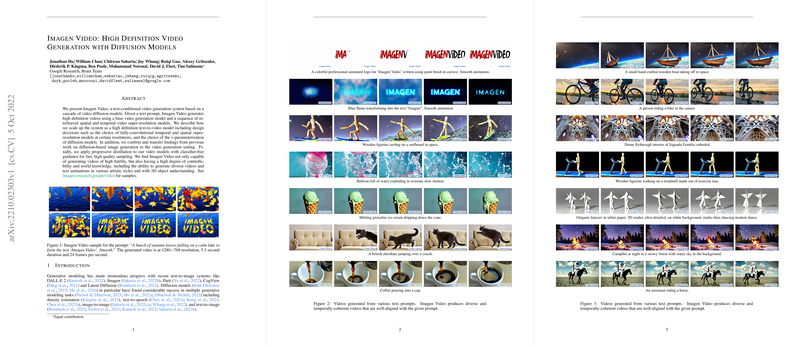Imagen Video: High Definition Video Generation with Diffusion Models
The paper "Imagen Video: High Definition Video Generation with Diffusion Models" presents a novel approach to generating high-definition (HD) videos from text inputs using a cascade of video diffusion models. This methodology leverages advancements in text-to-image generation and extends them to the temporal domain of video generation, providing a comprehensive pipeline that maintains high fidelity across both spatial and temporal domains.
Key Contributions and Architectural Highlights
Cascaded Diffusion Models
The core innovation of Imagen Video lies in its cascaded diffusion model architecture, consisting of a base video generation model followed by successive spatial and temporal super-resolution models. Specifically, the architecture begins with the generation of low-resolution video frames that are progressively enhanced to HD quality through a series of super-resolution steps. This cascading method scales effectively to handle the increased dimensions inherent in video data, enabling the production of 1280×768 resolution videos at 24 frames per second.
Diffusion Model Techniques
- Base Video Generation Model: The base video model employs a Video U-Net architecture that integrates spatial and temporal convolutions with attention mechanisms, allowing for the generation of temporally coherent and spatially detailed video segments. This model alone supports up to 128 frames.
- Super-Resolution Models: The spatial super-resolution models enhance frame resolution, while temporal super-resolution models interpolate frames to maintain consistency and smoothness in motion. These models ensure that the generated videos maintain high fidelity and continuity at every resolution scale.
Important Findings and Techniques
Text Conditioning and v-Prediction
Text conditioning is achieved using embeddings from a frozen T5-XXL text encoder, which has proven crucial for generating high-quality videos consistent with text prompts. Additionally, the use of the v-prediction parameterization (where v≡αt−σtx) is emphasized for its numerical stability and ability to avoid common artifacts like color shifting, especially in higher-resolution models.
Classifier-Free Guidance
To ensure the generated videos closely align with text prompts, classifier-free guidance is employed. This method involves adjusting the denoising model’s predictions by emphasizing the text-conditioned signal, substantially enhancing perceptual quality and alignment. Dynamic clipping and oscillating guidance weights are used to mitigate saturation issues, a common problem in large guidance settings.
Evaluation and Performance
The efficacy of the proposed architecture is validated through extensive experiments that showcase the Imagen Video system's ability to generate diverse and detailed videos. The paper provides comprehensive evaluation metrics such as FID, FVD, and CLIP scores, with the results suggesting that the proposed v-parameterization converges more rapidly than −predictionintermsofsamplequalitymetrics.</p><h3class=′paper−heading′>ImplicationsandFutureWork</h3><p>TheintroductionofImagenVideosignifiessignificantprogresstowardgeneratingcomplexvisualcontentpurelyfromtextualdescriptions,expandingthepotentialapplicationsofgenerativemodels.Inpractice,thistechnologycouldrevolutionizecreativeindustriessuchasanimation,filmmaking,andgamedesignbyautomatingthegenerationofconsistentandhigh−fidelityvideocontent.</p><p>However,ethicalconcernsmustbeaddressed,particularlyregardingthemisuseofgenerativemodelsforproducingdeceptiveorharmfulcontent.Thepaperacknowledgestheserisksandunderscorestheimportanceofimplementingrobustfiltermechanismsandfurtherdevelopingethicalguidelinesfordeployingsuchtechnologies.</p><h3class=′paper−heading′>Conclusion</h3><p>ImagenVideorepresentsasignificantstepforwardinthefieldofgenerativemodelingbysuccessfullyscalingtext−to−imagediffusionmodelstovideogeneration.Thecascadeofvideodiffusionmodels,textconditioningusingfrozenT5−XXLembeddings,andadvancedtechniqueslikeclassifier−freeguidanceandv$-prediction contribute to its ability to generate high-definition, temporally coherent videos from text inputs. Future advancements are expected to further enhance the performance and applicability of such models, ensuring they remain aligned with ethical standards in AI development.
